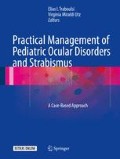Abstract
Bleeding into the anterior chamber (hyphema) occurs most commonly after blunt or penetrating injuries, but also in a number of other settings. Complications include elevation of intraocular pressure and its consequences as well as corneal blood staining, and vision loss from associated injuries. The risk of complications is believed to be higher in patients with sickle cell disease. Although there is no consensus on the use of various medications in patients with hyphema, most ophthalmologists agree that cycloplegics, topical steroids, and anti-glaucoma medications are important and prevent complications such as elevated intraocular pressure, posterior synechiae, and possibility of rebleeds. Management of pediatric patients as out or inpatients and the restriction of their level of activity continue to be debated, as is the use of systemic anti-fibrinolytics and oral steroids. It is critical to identify associated ocular, orbital, or other accompanying injuries. The surgical evacuation of blood from the anterior chamber is considered and performed in cases in which the hyphema does not resolve and intraocular pressure is significantly elevated.
Access this chapter
Tax calculation will be finalised at checkout
Purchases are for personal use only
References
Traumatic Hyphema: American Academy of Ophthalmology, 2007.
Shimada Y, Horiguchi M, Okubo T. Bilateral spontaneous hyphema with uveitis in a young girl. J Pediatr Ophthalmol Strabismus. 2004;41:114–5.
Rao A, Padhy D. The child with spontaneous recurrent bleeding in the eye. BMJ Case Rep. 2014;2014.
Chraibi F, Bhallil S, Benatiya I, Tahri H. Hyphema revealing retinoblastoma in childhood. A case report. Bull Soc Belge Ophtalmol. 2011:41–3.
Carrasquillo AM, Gupta BK, Wilensky JT. Recurrent hyphema in an aphakic child: Swan syndrome. J AAPOS. 2001;5:55–7.
Trief D, Adebona OT, Turalba AV, Shah AS. The pediatric traumatic hyphema. Int Ophthalmol Clin. 2013;53:43–57.
SooHoo JR, Davies BW, Braverman RS, Enzenauer RW, McCourt EA. Pediatric traumatic hyphema: a review of 138 consecutive cases. J AAPOS. 2013;17:565–7.
Shazly TA, Al-Hussaini AK. Pediatric ocular injuries from airsoft toy guns. J Pediatr Ophthalmol Strabismus. 2012;49:54–7.
Nasrullah A, Kerr NC. Sickle cell trait as a risk factor for secondary hemorrhage in children with traumatic hyphema. Am J Ophthalmol. 1997;123:783–90.
Hooper CY, Fraser-Bell S, Farinelli A, Grigg JR. Complicated hyphaema: think sickle. Clin Experiment Ophthalmol. 2006;34:377–8.
Rocha KM, Martins EN, Melo Jr LA, Moraes NS. Outpatient management of traumatic hyphema in children: prospective evaluation. J AAPOS. 2004;8:357–61.
Gharaibeh A, Savage HI, Scherer RW, Goldberg MF, Lindsley K. Medical interventions for traumatic hyphema. Cochrane Database Syst Rev. 2013;12, CD005431.
Beiran I, Talmon T, Miller B. Characteristics and functional outcome of traumatic hyphema without routine administration of epsilon-aminocaproic acid. Isr Med Assoc J. 2002;4:1009–10.
Rahmani B, Jahadi HR, Rajaeefard A. An analysis of risk for secondary hemorrhage in traumatic hyphema. Ophthalmology. 1999;106:380–5.
Walton W, Von Hagen S, Grigorian R, Zarbin M. Management of traumatic hyphema. Surv Ophthalmol. 2002;47:297–334.
Jabs DA, Nussenblatt RB, Rosenbaum JT, Standardization of Uveitis Nomenclature Working G. Standardization of uveitis nomenclature for reporting clinical data. Results of the First International Workshop. Am J Ophthalmol. 2005;140(3):509–516.
Author information
Authors and Affiliations
Corresponding author
Editor information
Editors and Affiliations
Rights and permissions
Copyright information
© 2016 Springer Science+Business Media, LLC
About this chapter
Cite this chapter
Wierda, S.B., Ariss, M.M. (2016). Management of the Patient with Hyphema. In: Traboulsi, E., Utz, V. (eds) Practical Management of Pediatric Ocular Disorders and Strabismus. Springer, New York, NY. https://doi.org/10.1007/978-1-4939-2745-6_15
Download citation
DOI: https://doi.org/10.1007/978-1-4939-2745-6_15
Published:
Publisher Name: Springer, New York, NY
Print ISBN: 978-1-4939-2744-9
Online ISBN: 978-1-4939-2745-6
eBook Packages: MedicineMedicine (R0)

